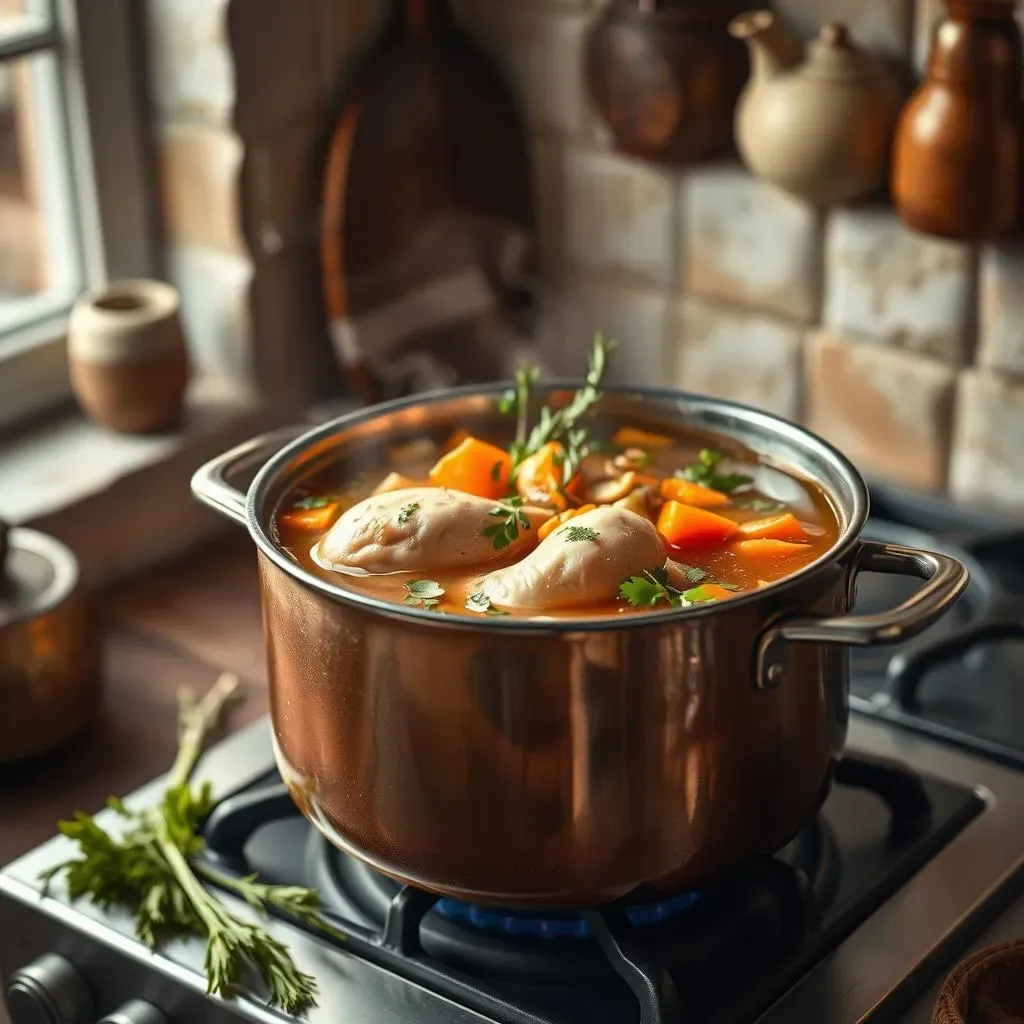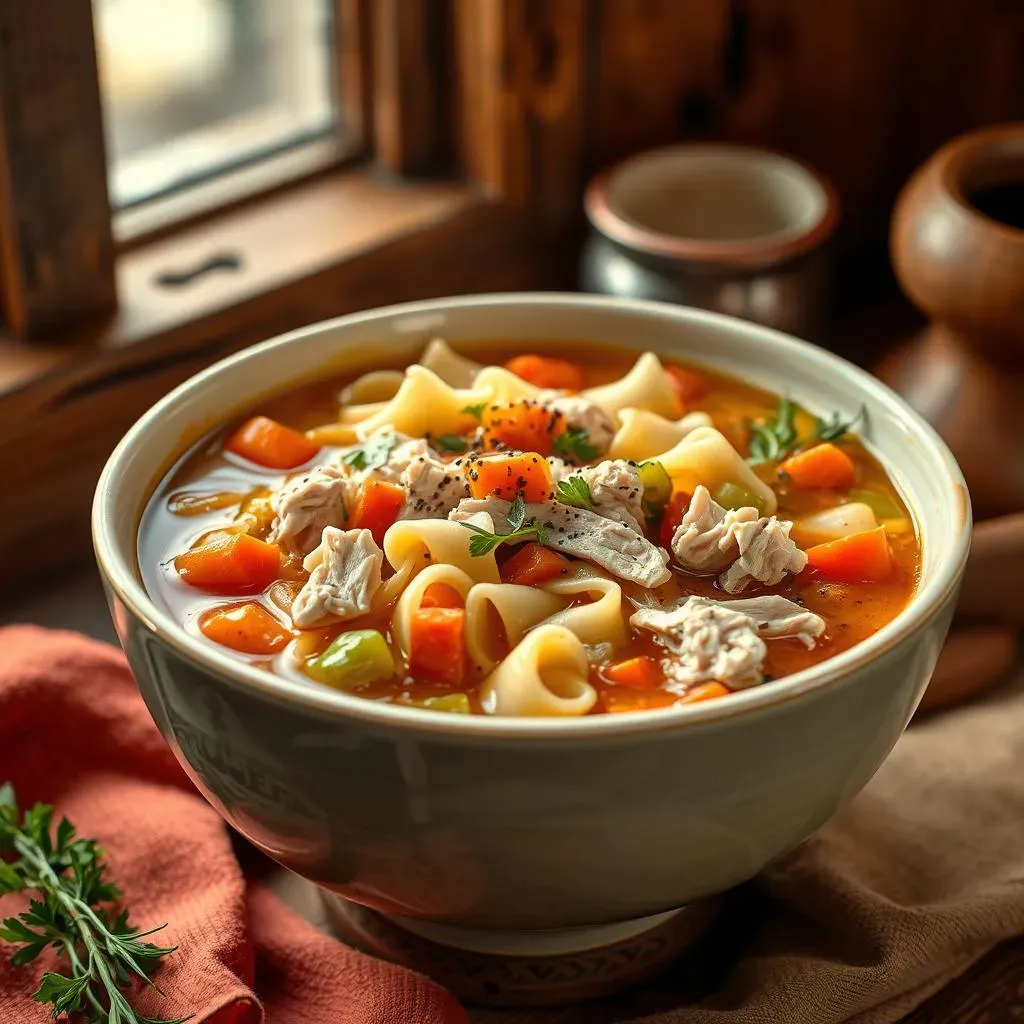Table of Contents
Nothing beats the warmth and comfort of a steaming bowl of homemade chicken noodle soup, especially on a chilly evening. But what if I told you could elevate this classic comfort food to new heights using leftover Thanksgiving turkey? This article is your guide to creating the ultimate "homemade chicken noodle soup with turkey," a dish that's both delicious and surprisingly easy to make. We'll walk you through every step, from transforming your leftover turkey carcass into a flavorful broth to assembling a perfect bowl of noodle-y goodness. Get ready to discover how simple ingredients can create a truly unforgettable meal that’s perfect for using up those holiday leftovers. We'll explore techniques to maximize the turkey's flavor, share tips for creating a rich and flavorful broth, and guide you in assembling the perfect bowl of this comforting classic. Prepare to be amazed by how easily you can transform simple ingredients into a culinary masterpiece! So grab your apron, let's get cooking, and prepare for a soup-erb experience!
Using Leftover Turkey for Maximum Flavor

Using Leftover Turkey for Maximum Flavor
Let's face it, Thanksgiving leftovers are amazing, but sometimes that turkey just sits there, staring at you. Don't let it go to waste! That turkey carcass is a goldmine of flavor, just waiting to be transformed into an unbelievably delicious broth for your soup. Instead of tossing it, think of it as the secret ingredient to a truly exceptional homemade chicken noodle soup with turkey. We're not just talking about adding shredded turkey to the end; we're talking about unlocking the deep, savory essence of the bird itself. This is where the magic happens. Think of the rich, complex flavors that will infuse your soup – a depth of taste that simply can't be replicated with store-bought broth. And the best part? It's incredibly easy! You’ll be surprised at how much flavor you can extract from those bones and scraps. For even more inspiration, check out our rotisserie chicken soup recipe – it uses a similar principle of maximizing flavor from the readily available poultry.
Turkey Part | Flavor Contribution |
|---|---|
Carcass (bones, skin) | Richness, collagen (for body) |
Dark meat | Deep, savory flavor |
White meat | Mild, slightly sweet flavor |
One of my favorite tips is to roast the turkey carcass before making the broth. This step intensifies the flavor profile tenfold. Seriously, it's a game-changer! Simply toss the carcass in the oven at 350°F (175°C) for about 30 minutes, until lightly browned. This step caramelizes the bones and skin, releasing even more deliciousness into your broth. Trust me on this one; it's the secret weapon for a truly unforgettable soup. And while we're on the subject of maximizing flavor, let's not forget the aromatics! Onions, carrots, and celery are your best friends here. Sautéing them before adding them to the broth creates a beautiful base of flavor that complements the turkey perfectly. For a twist, you can explore some variations like adding some fresh herbs. Check out our recipe with fresh herbs for more ideas.
- Roast the turkey carcass for deeper flavor.
- Don't forget the aromatics (onions, carrots, celery).
- Simmer the broth for at least 2 hours for maximum extraction of flavor.
Crafting the Perfect Broth: From Turkey Carcass to Culinary Gold

Crafting the Perfect Broth: From Turkey Carcass to Culinary Gold
The Foundation: Building a Flavorful Base
Okay, so we've got our roasted turkey carcass – high five! Now, let's talk about building that incredible broth. Think of this as the heart and soul of your soup. You want it rich, flavorful, and deeply satisfying. Start by adding plenty of water to a large stockpot – enough to comfortably cover the carcass. Then, we add our aromatics: onions, carrots, and celery, finely chopped. These guys aren't just for show; they contribute a beautiful sweetness and depth to the broth. And don't forget the herbs! Bay leaves, thyme, and parsley are classic choices, but feel free to experiment. A sprig of rosemary or a few peppercorns can add interesting nuances. Remember, we’re aiming for a symphony of flavors, not just a single note. For a simpler approach, check out our easy recipe which simplifies the broth-making process.
- Use plenty of water to cover the carcass.
- Finely chop your aromatics (onions, carrots, celery).
- Experiment with herbs and spices for unique flavor profiles.
The Simmering Process: Patience is Key
Now comes the crucial part: simmering. This isn't a race; it's a marathon of flavor extraction. Bring your broth to a gentle simmer, then reduce the heat to low. Cover the pot and let it simmer for at least two hours, preferably longer. The longer it simmers, the richer and more complex the broth will become. Think of it as a slow dance between the turkey bones and the water, a gentle extraction of all the wonderful flavors locked inside. During this time, you can periodically skim off any foam or impurities that rise to the surface. This step helps to keep your broth crystal clear. Once the simmering is done, you'll strain the broth through a fine-mesh sieve to remove all the solids, leaving you with a golden elixir of pure turkey deliciousness. For a different method of making broth, try our recipe using bone broth.
Seasoning and Refinement: The Finishing Touches
After straining, taste your broth. Season it generously with salt and pepper. This is your chance to adjust the flavor to your liking. A pinch of salt enhances the other flavors, while pepper adds a little warmth and complexity. You can also add other seasonings, such as a touch of Worcestershire sauce or a splash of white wine, to add extra depth or complexity. But remember, less is often more. You don't want to overpower the delicate turkey flavor. At this point, you can decide whether to use the broth as-is, or to further refine it. For instance, you might want to reduce the broth to intensify its flavor. This is done by simmering the broth uncovered until it reaches your desired consistency. Reducing the broth intensifies its flavor and creates a richer, more concentrated taste, perfect for your soup. For an even more refined flavor, consider checking out our classic recipe for inspiration.
Seasoning | Effect |
|---|---|
Salt | Enhances flavors |
Pepper | Adds warmth and complexity |
Worcestershire Sauce | Adds umami and depth |
Building Your Bowl: Noodles, Veggies, and Turkey Goodness

Building Your Bowl: Noodles, Veggies, and Turkey Goodness
The Noodle Situation: Choosing Your Weapon
Now for the fun part: adding the ingredients that will transform your broth into a hearty and satisfying soup! First up, the noodles. Egg noodles are a classic choice, offering a soft, comforting texture that perfectly complements the rich broth. But don't be afraid to experiment! Try different shapes and sizes – ditalini, rotini, or even wide egg noodles. The choice is yours! For a gluten-free option, you could even use zucchini noodles or rice noodles. Remember, this is your soup, so make it your own. For some inspiration on noodle choices, check out our egg noodle soup recipe for ideas.
Another great option is to use different types of pasta. Consider using small pasta shapes like ditalini or orzo for a different textural experience. They cook quickly and absorb the flavor of the broth beautifully. If you're looking for a heartier soup, you can even add some small pasta shapes like elbow macaroni or shells. These will add a nice chewiness to the soup and soak up the delicious broth. For a truly unique twist, why not try using different types of noodles. Consider using rice noodles, which add a subtle sweetness and a slightly different texture. For a more detailed guide on using different noodles, you can check out our recipe using rice noodles.
- Egg noodles are a classic choice
- Experiment with different shapes and sizes
- Consider gluten-free alternatives like zucchini or rice noodles
Veggie Power-Up: Adding Freshness and Flavor
Next, let's talk veggies. Carrots, celery, and onions are the holy trinity of soup vegetables, adding sweetness and depth to the broth. But don't stop there! Feel free to get creative with your additions. Chopped mushrooms add an earthy note, while peas provide a pop of color and sweetness. A handful of spinach wilts beautifully into the hot broth, adding a boost of nutrients. And if you're feeling adventurous, consider adding some diced potatoes or green beans for extra heartiness. Remember, this is your chance to showcase your culinary creativity! For a more substantial soup, consider adding a variety of vegetables. Adding vegetables like corn, green beans, or diced potatoes will make the soup even more hearty and nutritious. You can also experiment with different types of vegetables to add a unique flavor profile to your soup. For more vegetable-forward ideas, check out our recipe packed with vegetables.
Don't forget about herbs! Fresh herbs like parsley, thyme, or rosemary add a fresh, bright flavor that complements the richness of the turkey broth. Adding them at the end allows their flavors to shine through without being overcooked. A squeeze of lemon juice at the very end brightens the flavors and adds a hint of acidity that balances the richness of the broth. For a more detailed guide on using fresh herbs, take a look at our recipe featuring fresh herbs.
Vegetable | Flavor Profile |
|---|---|
Carrots | Sweet |
Celery | Subtle, slightly earthy |
Onions | Sharp, savory |
Turkey Time: Adding the Star of the Show
Finally, it's time to add the star of the show: your leftover turkey! Shred the turkey meat from the bones, discarding the skin and any tough bits. You can use both dark and white meat – both contribute to the overall flavor profile. Add the shredded turkey to the soup during the last 10-15 minutes of cooking. This allows the turkey to heat through and absorb the flavors of the broth without becoming dry or tough. For a richer flavor, you can brown the shredded turkey in a pan before adding it to the soup. This adds a depth of flavor that complements the broth beautifully. For a simpler approach, you can simply add the shredded turkey directly to the pot. For a comprehensive guide on making this soup, check out our step-by-step recipe.
Once the noodles are cooked through and the turkey is heated, your soup is ready! Ladle it into bowls and garnish with fresh herbs, a sprinkle of black pepper, or a dollop of sour cream or crème fraîche. Serve it hot and enjoy the fruits of your labor. It's the perfect comfort food, guaranteed to warm you from the inside out. And if you happen to have any leftover soup, don't worry! It tastes even better the next day, the flavors having had time to meld and deepen. For a healthier version of this soup, check out our healthy recipe.
